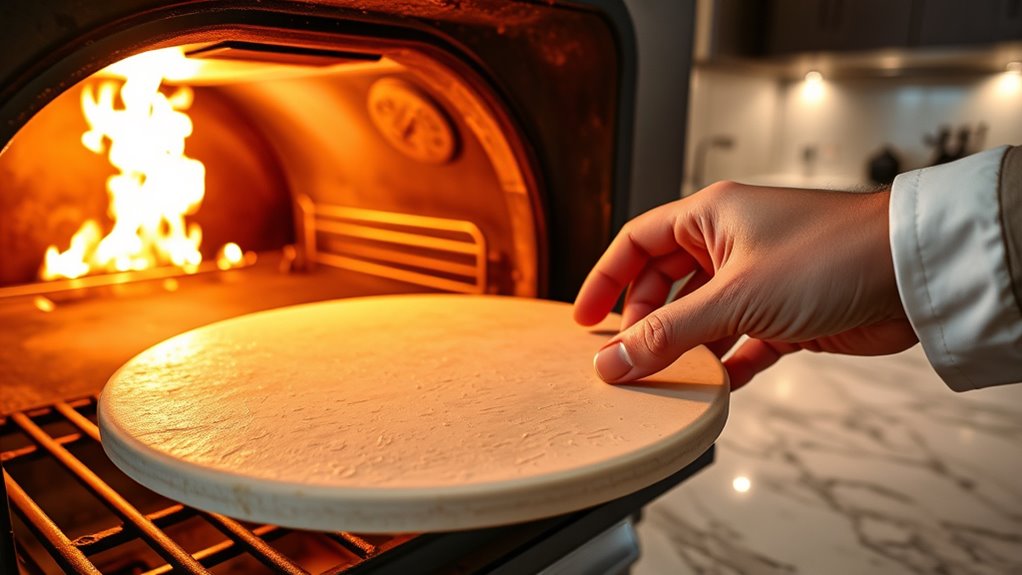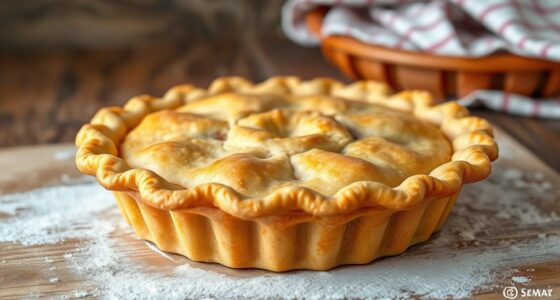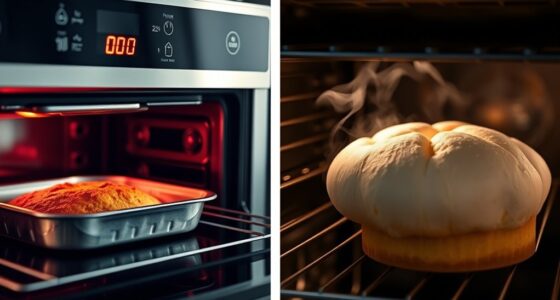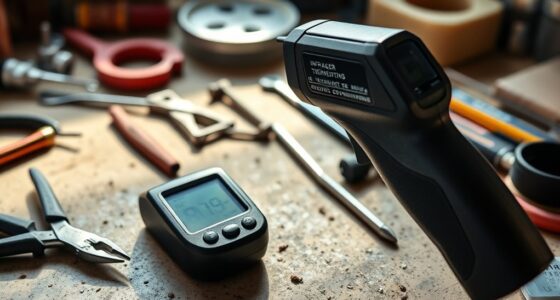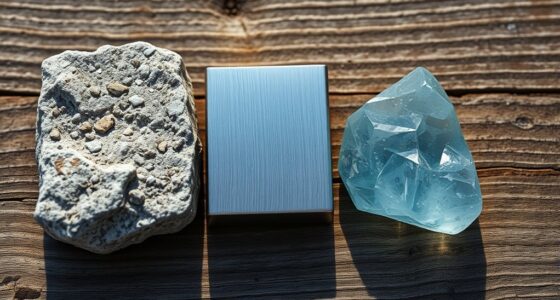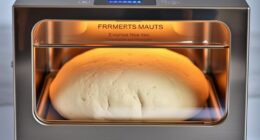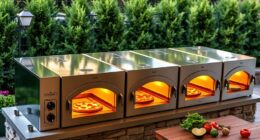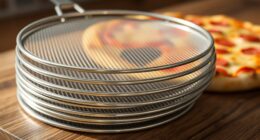To avoid common preheating mistakes, make certain you preheat your oven long enough—about 15-30 minutes—and at the correct temperature, ideally 450-500°F, with an oven thermometer for accuracy. Don’t forget to use a pizza stone or steel and position your rack properly. Avoid opening the door early or overloading the oven, and adjust preheat times based on your oven type. Master these tips to improve your pizza results; more expert advice awaits.
Key Takeaways
- Always allow at least 15-30 minutes for full oven preheat before baking pizza.
- Use an oven thermometer to verify accurate preheat temperature and avoid guesswork.
- Resist the temptation to open the oven door early; keep it closed until fully preheated.
- Properly position your pizza on a preheated stone or steel for even heat transfer.
- Avoid rushing preheat, especially in convection ovens, to prevent uneven baking and soggy crusts.
Not Preheating the Oven Long Enough
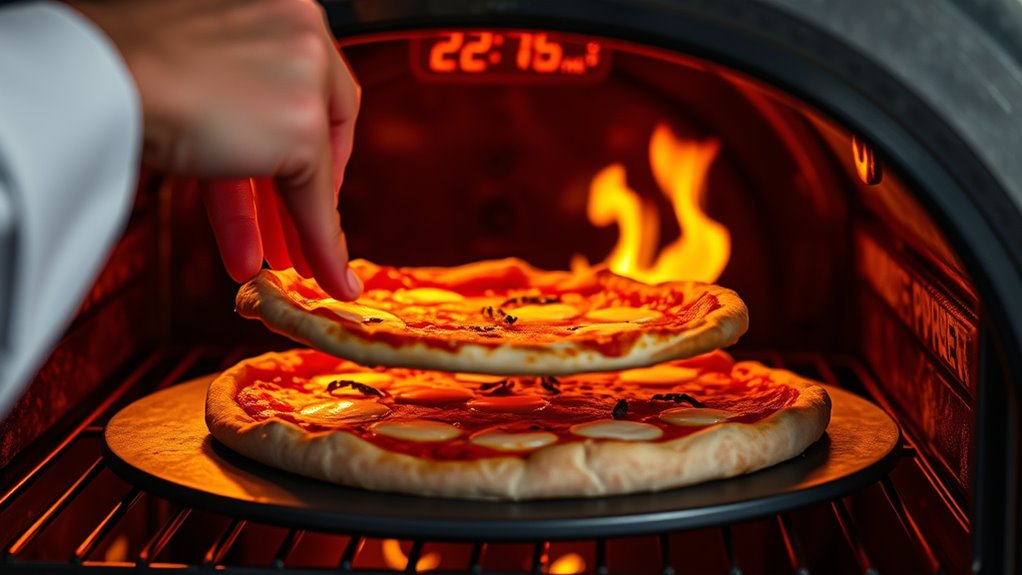
If you don’t preheat the oven long enough, your pizza may not cook evenly or develop the desired crispy crust. The preheat duration is vital; rushing this step leaves the oven temperature unstable, resulting in uneven baking. Proper oven calibration ensures your oven heats accurately, so you don’t rely on guesswork. If your oven isn’t calibrated correctly, even a sufficient preheat time might not reach the intended temperature. Always give your oven enough time to reach the target heat—typically 15-30 minutes for most home ovens. Skimping on preheat time can cause soggy spots or undercooked centers. Adjust your preheat duration based on your oven’s calibration, and don’t skip this step to achieve that perfect pizza crust. Using essential oils for oven maintenance or cleaning can help keep your oven functioning properly and ensure consistent heat.
Preheating at the Wrong Temperature Setting
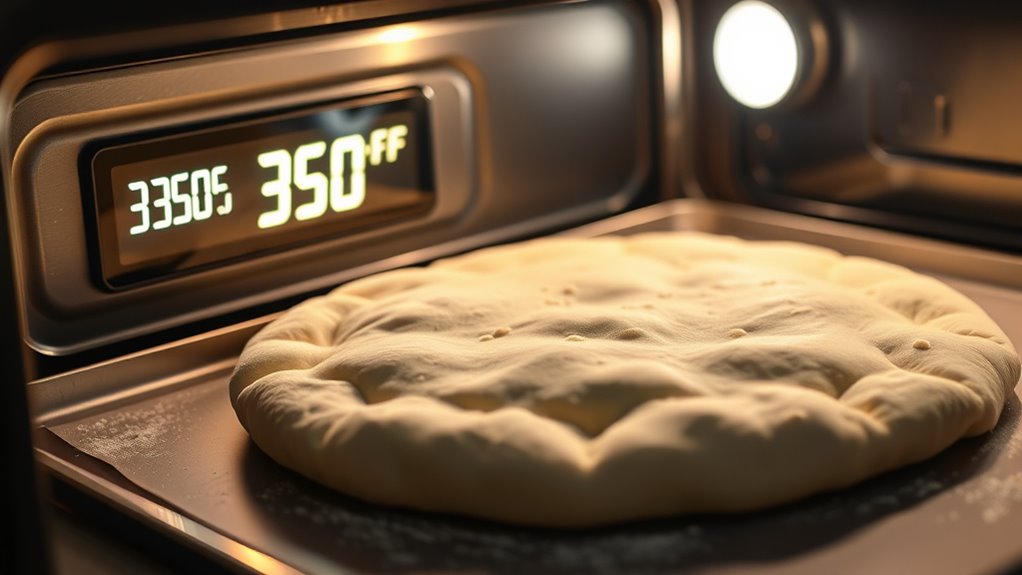
If you set your oven too high or too low, your pizza won’t cook properly. Overheating can burn the crust before the toppings are ready, while underheating leaves the pizza underdone. Getting the temperature just right is vital for a perfectly baked pie. For optimal results, consider the tuning of your oven to ensure it matches the ideal preheat temperature for pizza.
Wrong Oven Temperature
Preheating your oven to the correct temperature is essential for a perfectly cooked pizza, yet many people set it too high or too low, which can ruin the crust and toppings. If your oven temperature is off, heat distribution can become uneven, causing parts of your pizza to burn while others remain undercooked. A lower temperature might result in a soggy crust, while a higher one can burn the toppings before the crust is fully baked. To avoid this, always preheat your oven to the recommended temperature for your pizza style, typically around 450-500°F. Using an oven thermometer can help guarantee accurate heat distribution. Proper oven temperature assures the crust crisps up nicely while toppings cook evenly, giving you that perfect slice every time. Additionally, understanding your oven’s specific flushing mechanisms can help in maintaining consistent heat levels for optimal baking results.
Over or Under Heating
Setting the oven to the wrong temperature can sabotage your pizza before it even starts cooking. If your oven isn’t properly calibrated, it might heat unevenly, leading to over or under heating. Overheating can cause the crust to burn or become too crisp, while underheating results in a soggy, undercooked center. To avoid this, use an oven thermometer to check your oven’s actual temperature and adjust accordingly. Proper preheating guarantees consistent heat, which helps maintain pizza dough consistency and prevents uneven cooking. Remember, relying solely on your oven’s dial can be misleading if it’s not calibrated correctly. Achieving the right temperature setting is vital for a perfectly cooked pizza with a crisp crust and evenly melted toppings. Additionally, understanding sector performance metrics can help you recognize how different oven types or heating technologies impact cooking results.
Forgetting to Use a Pizza Stone or Steel
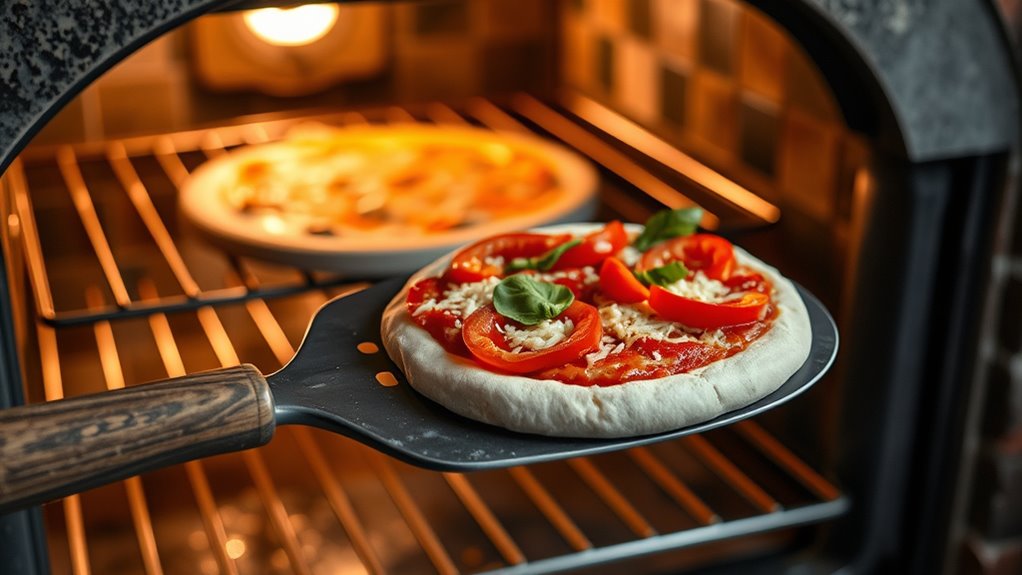
Many home bakers overlook the importance of using a pizza stone or steel, which can substantially affect your crust’s texture and overall success. Without it, your pizza dough may not develop that crisp, evenly cooked bottom you want. A stone or steel absorbs and retains high heat, helping you achieve a professional-looking crust. Plus, it promotes better topping distribution by preventing toppings from sliding or becoming soggy. Preheating the stone or steel along with your oven guarantees the heat is concentrated right where your pizza needs it most. Skipping this step can result in a soggy or uneven crust, ruining your pizza’s texture. Additionally, understanding oven‑to‑stone heat transfer can help you optimize your preheating process for even better results. For consistent results, always place your pizza on a preheated stone or steel, and you’ll notice a marked improvement in your pizza’s overall quality.
Preheating in Multiple Stages Instead of a Single, Hot Cycle
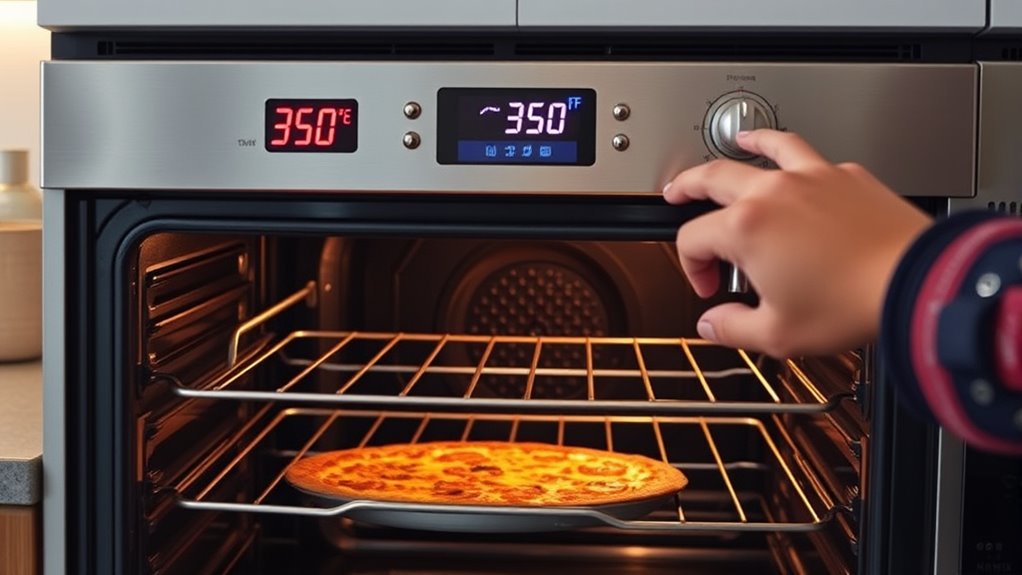
Preheating your oven in multiple stages can cause uneven heat distribution, which might lead to inconsistent pizza crusts. It can also extend your overall cooking time, risking undercooked spots or burnt edges. To get the best results, aim for a single, thorough preheat cycle that guarantees even, efficient cooking. Additionally, understanding the importance of temperature stability can help maintain consistent heat levels throughout the baking process.
Uneven Heating Risks
When you preheat your oven in multiple stages instead of a single, hot cycle, uneven heating can occur. This risk is often linked to poor oven calibration, which prevents consistent temperature distribution. Without proper calibration, some areas may heat faster than others, leading to inconsistent cooking results. Additionally, baking surface selection plays a critical role; using uneven or unsuitable surfaces can cause hot spots or cold zones, further contributing to uneven heat distribution. Properly calibrated ovens and the use of natural materials like stone or ceramic can help promote more even heat transfer. When you skip a thorough preheat at the right temperature, you compromise the oven’s ability to evenly transfer heat to your pizza. To avoid this, ensure your oven is properly calibrated and choose a stable, heat-conductive baking surface. Consistent, single-cycle preheating promotes even heat, giving you perfectly cooked pizza every time.
Longer Cooking Time
Preheating your oven in multiple stages instead of a single, hot cycle can lead to longer cooking times for your pizza. When you don’t set the correct baking temperature from the start, the oven may need extra time to reach ideal heat, especially if it’s not properly calibrated. Inconsistent preheating causes the oven to cycle on and off, delaying the time it takes to achieve the desired temperature. This can result in uneven heat distribution, prolonging cooking. To avoid this, verify your oven is calibrated correctly and preheat it fully to the recommended temperature before placing your pizza inside. Rushing or skipping preheating stages can compromise your pizza’s crust and toppings, so patience and proper calibration are key for efficient, even cooking. Additionally, understanding regional architectural styles can enhance your appreciation of historic farmhouses’ construction methods and preservation needs.
Opening the Oven Door Too Early During Preheat
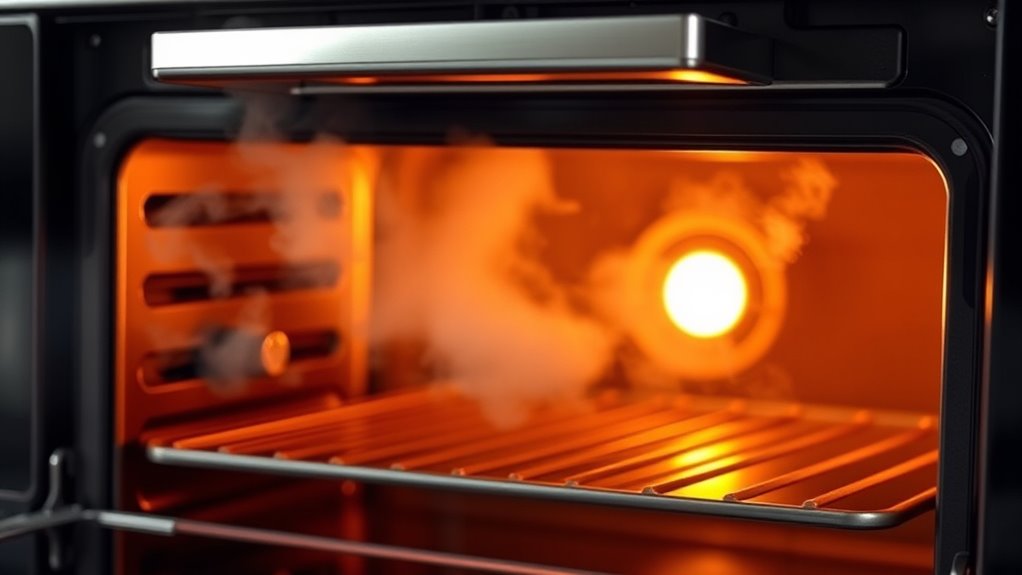
Opening the oven door too early during preheat can substantially disrupt the temperature buildup, making it harder to achieve the ideal cooking environment. When you open the oven door prematurely, heat escapes, causing the oven to cool down and extend the necessary preheat duration. This interruption can lead to uneven heating, which affects how your pizza will cook later. To get the best results, keep the oven door closed during the entire preheat process, allowing it to reach and stabilize at the desired temperature. Rushing to check the temperature or peek inside shortens the preheat duration and hampers heat retention. Patience is key—wait until the oven signals that it’s fully preheated before introducing your pizza for perfect crust and topping results. Understanding the importance of oven temperature stability can help you achieve consistent baking outcomes.
Not Allowing the Oven to Fully Stabilize Before Baking
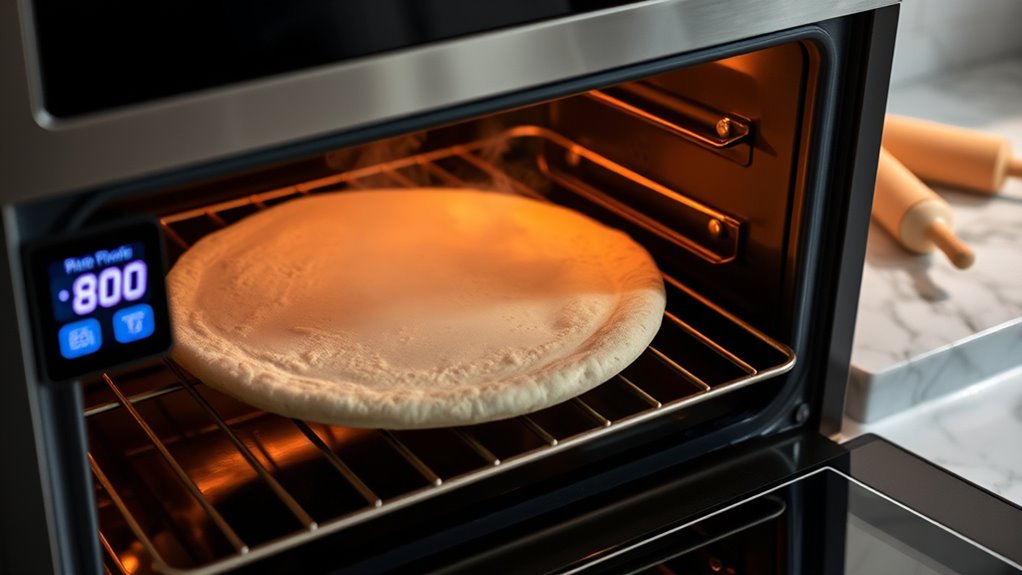
Skipping the wait for the oven to fully stabilize before baking can lead to uneven cooking and less-than-ideal results. When you don’t allow the oven to reach its proper temperature, you risk inconsistent temperature consistency, which affects how your pizza bakes. An uncalibrated oven or one that hasn’t stabilized can cause hotspots or temperature fluctuations, leading to uneven crust and toppings. To avoid this, give your oven ample time to preheat fully and ensure it maintains a steady temperature. Regular oven calibration helps maintain accurate readings, so your oven heats correctly every time. Rushing this process means your pizza might not cook evenly, compromising texture and flavor. Patience during this stage is key to achieving a perfectly baked pizza with excellent crust and toppings. Additionally, incorporating sound healing science concepts, like allowing your oven to stabilize, can enhance your overall baking experience by creating a more harmonious cooking environment.
Rushing the Preheat Process When Using a Convection Oven
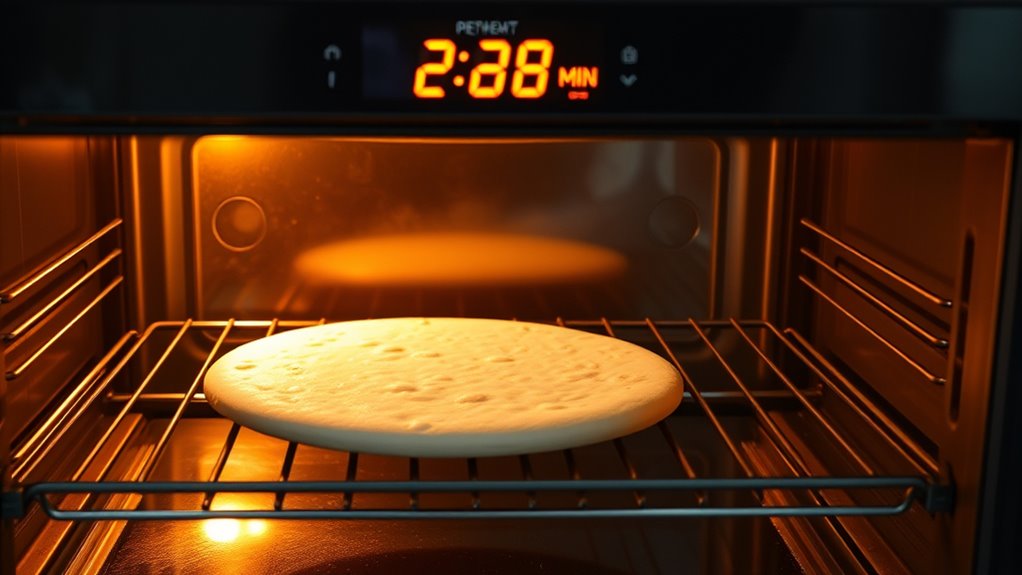
Although convection ovens heat more quickly and efficiently, rushing the preheat process can still cause problems. Skipping or shortening the preheat duration prevents the oven from reaching ideal convection heat, leading to uneven baking and soggy crusts. When you rush, you might open the oven too early or set it to a lower temperature, which hampers proper heat circulation. Visualize:
- A cold oven struggling to develop even heat
- Pockets of cool air disrupting the pizza’s base
- A crust that doesn’t crisp as expected
- Hot spots caused by uneven convection heat distribution
Taking the time for a full preheat ensures the convection heat is evenly distributed, giving you a perfectly baked pizza with a crisp crust and evenly melted toppings. Patience during preheat pays off in better results.
Ignoring the Oven’s Hot Spots and Uneven Heating
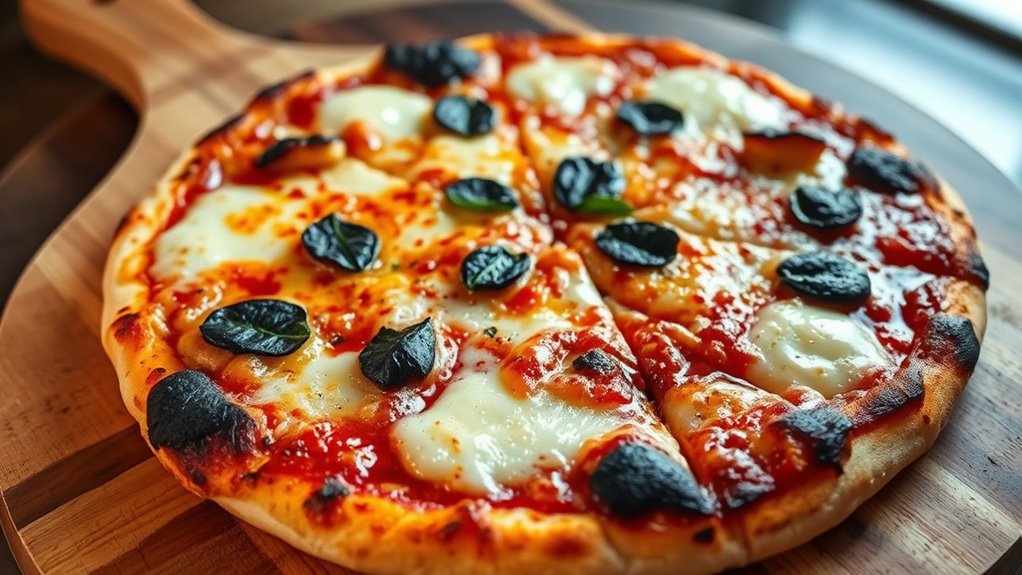
Hot spots and uneven heating are common issues that can ruin a perfectly prepared pizza. If you disregard these, your crust may burn while other parts remain undercooked. To prevent this, make sure your oven is properly calibrated; uncalibrated ovens can have unpredictable hot spots. Also, pay attention to baking surface selection—some materials distribute heat more evenly than others. For example, a pizza stone or steel can help promote uniform heat transfer, reducing hot spots. Rotate your pizza midway through baking to counteract uneven heat distribution. By addressing oven calibration and choosing the right baking surface, you can minimize hot spots and achieve a consistently well-cooked pizza. Ignoring these factors often leads to uneven results and wasted effort.
Preheating Without Properly Positioning the Rack or Pizza
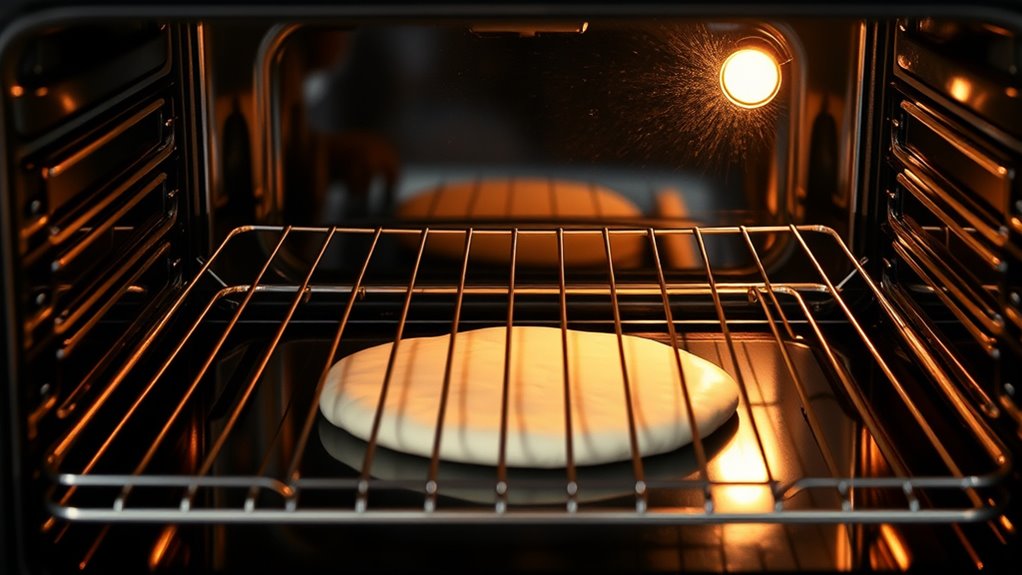
Proper oven preheating isn’t just about reaching the right temperature; it also depends on where you place your rack and pizza inside the oven. Incorrect oven rack positioning or pizza placement can lead to uneven cooking and a less-than-perfect crust.
Imagine:
- Placing the pizza too high, causing it to burn before cooking through
- Positioning the rack too low, making the crust soggy from insufficient heat
- Centering the pizza for even heat distribution
- Adjusting oven rack height based on the desired browning or crispiness
Using the Wrong Bakeware During Preheat
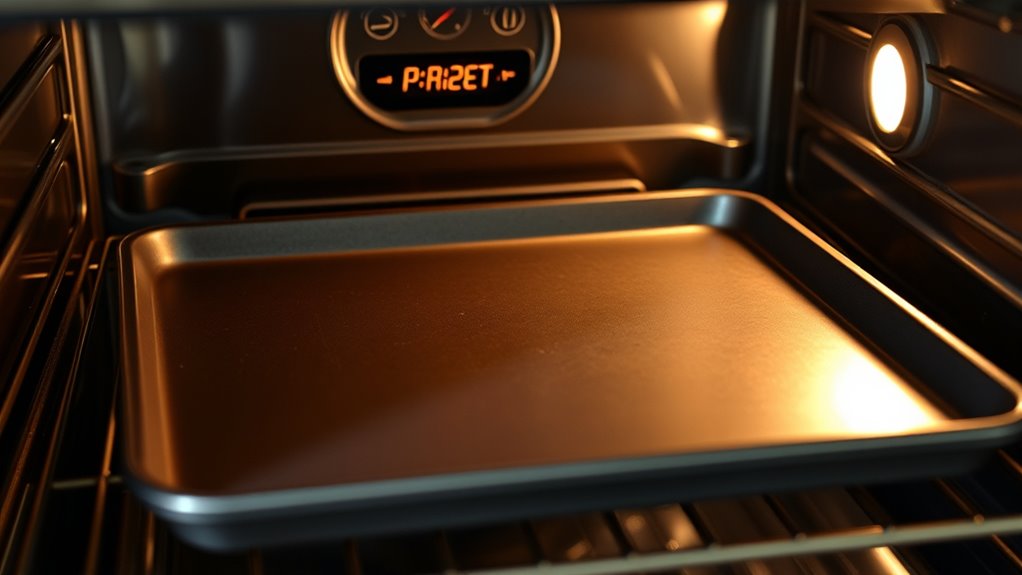
Using the wrong bakeware during preheat can considerably affect your pizza’s results. If you choose a baking sheet that’s too thick or doesn’t heat evenly, your crust may cook unevenly, leading to soggy spots or burnt edges. Avoid using flimsy or non-heat-conductive materials like thin aluminum foil or plastic bakeware, as they won’t give you the crisp crust you want. Instead, opt for baking accessories like a pizza stone or a perforated pizza pan, which help distribute heat more evenly. Be mindful of your pizza toppings too—if you pile on heavy or moist toppings, they can trap steam and affect how your bakeware performs. Using appropriate bakeware ensures your preheat process creates the perfect foundation for a delicious, well-cooked pizza.
Neglecting to Adjust Preheat Time for Different Oven Types

Not all ovens heat the same way, so preheat times can vary considerably. If you ignore these differences, your pizza might not cook evenly or reach the right temperature. Adjusting your preheat time based on your oven type ensures better results every time.
Oven Heating Differences
Since different oven types vary in how quickly they reach the desired temperature, neglecting to adjust your preheat time can lead to undercooked or unevenly baked pizza. Some ovens heat rapidly, while others take longer due to oven calibration issues or less durable heating elements. For example, a convection oven with a powerful fan heats evenly and quickly, whereas a standard coil oven may lag behind. Ignoring these differences means you might pull your pizza too early or too late, resulting in poor crust and toppings. Visualize:
- A blazing hot oven ready in 10 minutes, perfect for thin crusts
- An older oven struggling to reach high temps
- Uneven heat spots caused by weak heating elements
- Calibration issues leading to inconsistent results
Adjust your preheat time based on your oven’s specific heating characteristics for suitable pizza results.
Adjusting for Variations
To achieve perfectly baked pizza, you need to adjust your preheat time based on your oven’s specific characteristics. Different ovens, whether gas, electric, or convection, heat unevenly and require tailored preheating. If you’re making ingredient substitutions, like using a different flour or adding extra toppings, you might need to tweak the preheat to guarantee your crust cooks evenly. Proper dough preparation, including resting and shaping, also impacts how your oven’s heat interacts with your pizza. For example, thicker dough or denser ingredients may need a slightly longer preheat to reach the right temperature. Pay attention to your oven’s performance and make small adjustments to preheat times accordingly, optimizing your bake for consistent, delicious results every time.
Overloading the Oven During Preheat, Affecting Heat Circulation
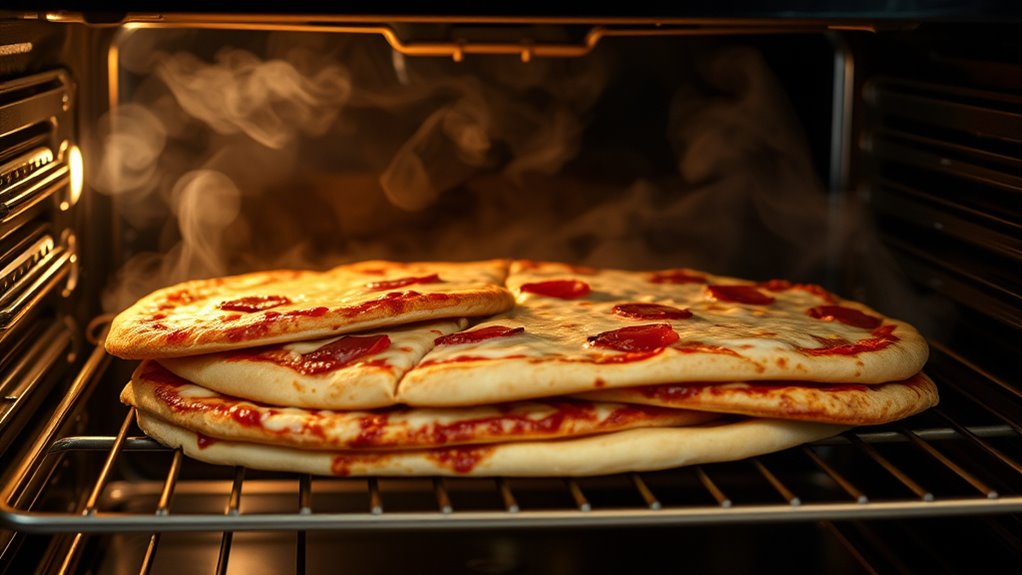
Overloading the oven during preheat can substantially disrupt heat circulation, leading to uneven cooking. When you cram in too many items or block vents, the airflow is hindered, preventing proper oven insulation and even heat distribution. This causes hot spots and cold spots, making your pizza cook unevenly. Imagine hot air bouncing chaotically inside, unable to circulate freely, which hampers consistent heat delivery.
- Piling high on the oven rack, blocking vents
- Placing large, bulky dishes that obstruct airflow
- Overcrowding with multiple trays, disrupting air circulation
- Using thick, insulating cookware that traps heat inside
Keep your oven clear of excess items and avoid blocking vents to ensure proper air circulation. This helps maintain consistent heat, vital for perfectly preheated pizza.
Frequently Asked Questions
How Do I Know When My Oven Has Reached the Right Preheat Temperature?
You’ll know your oven has reached the right preheat temperature when the oven’s indicator or thermometer shows the desired temperature, typically around 450-500°F for pizza. Rely on the oven’s preheat duration, usually 15-20 minutes, to guarantee it’s fully heated. Avoid opening the door early, as this can cause temperature fluctuations. Once the oven maintains the target oven temperature steadily, you’re ready to bake your pizza perfectly.
Can Preheating Times Vary for Different Pizza Dough Types?
Ever wonder if preheating times change with different pizza dough types? They definitely can, depending on dough hydration and proofing times. Higher hydration doughs may need a slightly longer preheat to guarantee a crisp crust, while well-proofed doughs heat more evenly. You should adjust your preheat based on the dough’s characteristics, aiming for a hot oven that quickly crisps the crust without overcooking the toppings.
Is It Necessary to Preheat for Thick-Crust Versus Thin-Crust Pizzas?
Yes, preheating is necessary for both thick- and thin-crust pizzas. You should preheat your oven to guarantee proper oven calibration and achieve even baking. For best results, place your baking stone in the oven early, allowing it to heat thoroughly. This helps create a crispy crust, especially for thick-crust pizzas. Preheating ensures consistent heat, preventing sogginess and ensuring your pizza bakes perfectly regardless of crust thickness.
How Does Preheating Impact the Overall Crust Texture?
If you preheat your oven with a baking stone, you’ll notice a crispier crust because the intense heat creates a rapid, even bake. For example, a home baker preheated for 30 minutes with good oven insulation achieved a golden, crunchy crust that mimicked a pizzeria. Without proper preheating, the crust turns out softer and less evenly cooked. Preheating guarantees your oven’s heat is consistent, giving you the perfect crust texture every time.
What Signs Indicate My Oven Isn’t Preheating Properly?
If your oven isn’t preheating properly, you’ll notice uneven heat distribution, with some areas hotter than others. You might also see temperature fluctuations on the oven display or find that your pizza takes longer to cook. To confirm, check your oven calibration with an oven thermometer. If readings are off, you may need to recalibrate or call a professional to fix heat distribution issues, ensuring your oven heats evenly and accurately.
Conclusion
By avoiding these 12 common preheat mistakes, you’ll guarantee your pizza comes out perfectly crispy and evenly cooked every time. Did you know that a properly preheated oven can reduce cooking time by up to 15%? Skipping or rushing the preheat process can ruin your pizza’s texture and flavor. Take the time to preheat correctly, and you’ll enjoy restaurant-quality results right in your own kitchen. Happy baking!
